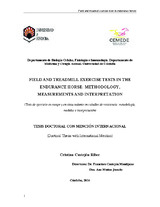Field and treadmill exercise tests in the endurance horse: methodology, measurements and interpretation
Tests de ejercicio en campo y en cinta rodante en caballos de resistencia: metodología, medidas e interpretación
Autor
Castejón Riber, Cristina
Director/es
Castejón Montijano, F.Muñoz, A.
Editor
Universidad de Córdoba, Servicio de PublicacionesFecha
2014Materia
CaballosForma física
Frecuencia cardíaca
Lactato
Resistencia
Test de ejercicio
Endurance
Exercise tests
Fitness
Heart rate
Horses
Lactate
METS:
Mostrar el registro METSPREMIS:
Mostrar el registro PREMISMetadatos
Mostrar el registro completo del ítemResumen
INTRODUCCIÓN. La valoración del estado de forma física es esencial para lograr el
máximo beneficio de un programa de entrenamiento y para reducir el riesgo de
sobreentrenamiento y lesiones. El método convencional para evaluar la forma física es el
test de ejercicio, en el que se procede a la medición de parámetros fisiológicos, de los que
se obtienen índices de funcionalidad, para su aplicación al diseño de programas de
entrenamiento individuales.
OBJETIVOS. 1) Describir tests de ejercicio en treadmill y campo para caballos de
resistencia, analizando cada uno de los factores que se deben diseñar (calentamiento,
número de cargas de esfuerzo, duración de cada carga, velocidad, tiempo de recuperación
entre cargas y enfriamiento); 2) Comparar nuestros tests con otros descritos en la
literatura; 3) Evaluar de forma crítica, los beneficios e inconvenientes de nuestros tests;
4) Analizar si los tests de ejercicio permiten la obtención de índices de funcionalidad.
HIPÓTESIS A COMPROBAR. Que los tests de ejercicio que usamos en el Centro de
Medicina Deportiva Equina (CEMEDE) para caballos de resistencia, son viables, y nos
permiten calcular índices de funcionalidad cardiovasculares y metabólicos.
MATERIAL Y MÉTODOS. Se han estudiado 46 caballos de resistencia, 29 hicieron un
test en treadmill y 17, en pista. El test en treadmill estuvo precedido por un calentamiento
(5 min al paso y 5 min al trote), con el treadmill sin inclinación, y siguió con cargas de
esfuerzo de intensidad progresiva, empezando a 5 m/s e incrementando la velocidad en 1
m/s cada 3 min hasta que el caballo fue incapaz de mantener la velocidad o se superaron
concentraciones de lactato en sangre de 4 mmol/l. El test se realizó con una inclinación
en el treadmill al 6%. El enfriamiento fue similar al calentamiento (5 min trote y 5 min
paso, con treadmill sin inclinación). El test de campo consistió en un calentamiento (1000
m al paso), seguido de cargas de esfuerzo, de 3 min de duración, iniciadas a 15 km/h, e
incrementando 3 km/h en cada carga. El enfriamiento consistió en 1000 m al paso.
Durante el test, se procedió a monitorizar la frecuencia cardíaca y se tomaron muestras de... BACKGROUND . Assessment of physical fitness is pivotal to reach the maximum
benefit from training programs, and to minimize the risk of overreaching, overtraining
and injuries. The conventional method to evaluate fitness is an exercise test, when
several physiological parameters are measured in order to obtain functional indices that
will be applied to establish individual training protocols.
OBJECTIVES. 1) To describe treadmill and field exercise tests for endurance horses
and, to analyze each of the factors that should be designed (warming-up, number of
workloads, duration, velocity, time of recovery between workloads, warming-down
period); 2) To compare our tests with others described in the literature; 3) To critically
analyze the benefits and disadvantages of our tests and 4) To evaluate whether these tests
allow the calculation of functional indices.
HYPOTHESIS TO CHECK. We hypothesized that the treadmill and field exercise tests
used in the Equine Sport Medicine Centre (CEMEDE) for endurance horses, are easy to
perform, and they permit the calculation of cardiovascular and metabolic indices related
to performance.
MATERIAL AND METHODS. Forty-six endurance horses were studied, 29 performed
a treadmill exercise test and 17, a field exercise test. The treadmill exercise test was
preceded by a warming-up of 5 min at walk and 5 min at trot with the treadmill
uninclined. The test started at 5 m/s, with a slope of 6% and the velocity was increased by
1 m/s every 3 min, until the horse was not longer able to keep the required velocity or a
blood lactate concentration higher than 4 mmol/l was reached. The test ended with a
warming-down period, 5 min at trot and 5 min at walk with the treadmill unclined. The
field exercise test was preceded by a warming-up of 1000 m at walk, and it started with a
workload of 15 km/h, of 3 min of duration, increasing the velocity by 3 km/h in each
workload. The warming-down consisted in covering 1000 m at walk. During the tests,...

